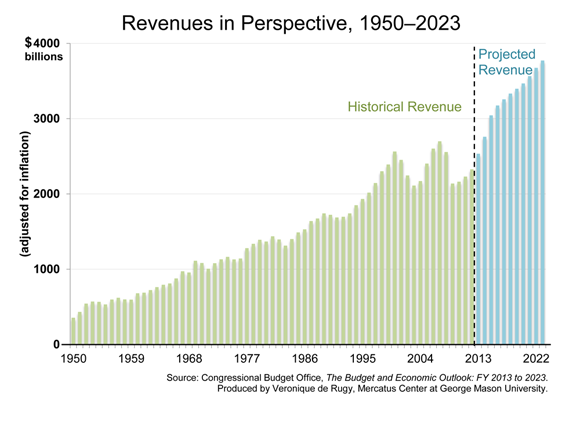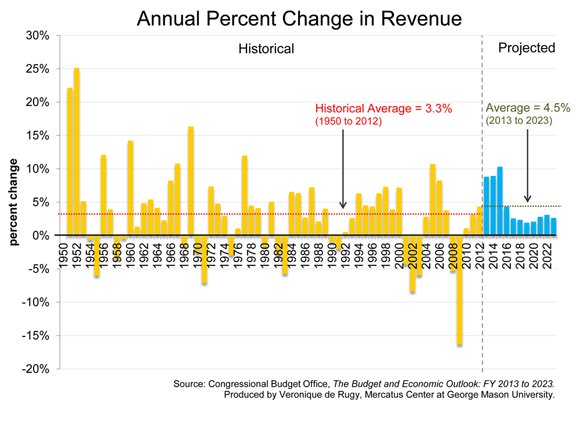- | Government Spending Government Spending
- | Data Visualizations Data Visualizations
- |
Growth Trends in Revenue Collection Since 1950
If current law remains unchanged, the CBO estimates that revenues in 2013 will equal $2.7 trillion or 16.9 percent of GDP—up from 15.8 percent of GDP in 2012 and the highest percentage of GDP estimate since 2008. Tax collection is projected to double from its 2012 levels to reach $4,961 billion by 2023. This is overly optimistic.
The Congressional Budget Office (CBO) projects that by 2023 the deficit will be roughly $1 trillion and public debt will reach 77 percent of GDP. As dire as that sounds, these projections rely on rosy economic growth assumptions and revenue projections that are unlikely to materialize.
These charts use historical and projected CBO data adjusted for inflation to examine growth trends in revenue collection since 1950.
If current law remains unchanged, the CBO estimates that revenues in 2013 will equal $2.7 trillion or 16.9 percent of GDP—up from 15.8 percent of GDP in 2012 and the highest percentage of GDP estimate since 2008. Tax collection is projected to double from its 2012 levels to reach $4,961 billion by 2023. This is overly optimistic.
The annual projected revenue growth between 2013 and 2023 is 4.5 percent, which is much higher than the historical average of 3.3 percent. In particular, revenue is projected to grow at an average annual rate of over 9 percent for the next three years. This is nearly three times the historical average. Moreover, as the second chart shows, the CBO projects a positive revenue collection growth for ten consecutive years, an unprecedented trend.
And, while the projected rate of growth in revenue slows slightly between 2016 and 2019, total revenue is still projected as increasing each year. According to CBO, “Federal revenues will increase by roughly 25 percent between 2013 and 2015 under current law.” That amounts to an increase in revenue collection of $665 billion during this time (see the blue bars in both charts). Total revenue is expected to double, increasing by $2.5 trillion between 2012 and 2023, yet still generating a deficit of around $1 trillion.
Under a more realistic assumption of revenues, the actual deficit in 2023 might be even higher.



